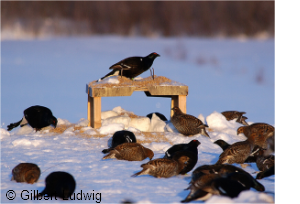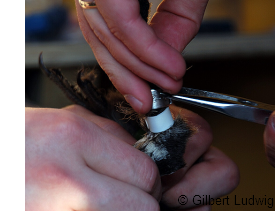Overview of Research Techniques
Our research techniques reflect our multi-facted work. As well a core component of field work, our work is heavily focussed on laboratory methods. Techniques we use include qPCR quantification of avian haemosporidians , enzyme-linked immunoassays (ELISA), optical spectrometric measurements and colour spectra analysis.
Work in the field
 We have 5 long-term field sites where we study black grouse, situated approximately 50km west of Jyvaskyla. These five sites form the core of our research, but during certain periods, we have expanded out trapping and monitoring up to 12 sites. These 5 core sites (Teerisuo, Kummunsuo, Lehtosuo, Saarisuo, Valkkeisuo) comprise 5 different wintering flocks and lekking sites. We trap annually at these sites and monitor the spring leks from hides.
We have 5 long-term field sites where we study black grouse, situated approximately 50km west of Jyvaskyla. These five sites form the core of our research, but during certain periods, we have expanded out trapping and monitoring up to 12 sites. These 5 core sites (Teerisuo, Kummunsuo, Lehtosuo, Saarisuo, Valkkeisuo) comprise 5 different wintering flocks and lekking sites. We trap annually at these sites and monitor the spring leks from hides.
 All captured birds are ringed with a numbered metal ring and coloured plastic rings that allow identification on the lek. We take a number of samples such as blood and feather samples, and measurements such as body mass, lyre length, eye comb size. Some females are fitted with radiotransmitters. This allows us to find their nests in spring time. We locate nests and calcualte the hatching date. We measuring the eggs and return on the predicted day of hatching to sample and measure the nestlings. We have also been able to use the transmitters to monitor brood survival.
All captured birds are ringed with a numbered metal ring and coloured plastic rings that allow identification on the lek. We take a number of samples such as blood and feather samples, and measurements such as body mass, lyre length, eye comb size. Some females are fitted with radiotransmitters. This allows us to find their nests in spring time. We locate nests and calcualte the hatching date. We measuring the eggs and return on the predicted day of hatching to sample and measure the nestlings. We have also been able to use the transmitters to monitor brood survival.

Laboratory analysis
 We routinely conduct a number of analyses in our laboratory. These include enzyme-linked immunoassays (ELISA), carotenoid analysis optical spectrometric measurements and colour spectra analysis. We also genotype adult and chick samples, allowing us to assign parentage to nestlings. We collaborate with our researchers such as Jacob Höglund on MHC analysis and have ongoing work on telomeres.
We routinely conduct a number of analyses in our laboratory. These include enzyme-linked immunoassays (ELISA), carotenoid analysis optical spectrometric measurements and colour spectra analysis. We also genotype adult and chick samples, allowing us to assign parentage to nestlings. We collaborate with our researchers such as Jacob Höglund on MHC analysis and have ongoing work on telomeres.
We have also developed a nested qPCR for the identification and quantification of avian haemsporidians. We often host researchers in our laboratory to learn techniques and frequently have trainees from local polytechnics. For persons interested in training in our laboratory, contact Anssi Lipponen.
Field-condition experiments
Some of our past research has also involved carrying our experiements both in the field and in controlled conditions. Captive studies have made excellent use of the Konnevesi field research station located 60km north of Jyvaskyla. In particular, we have used the large avian laboratory and smaller arena rooms for work on magpies and blue tits.



